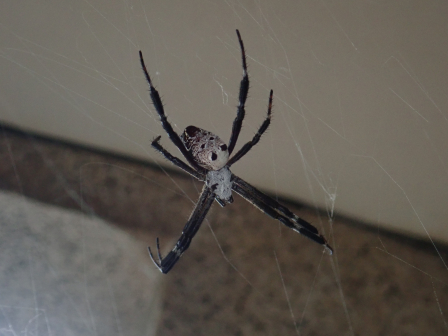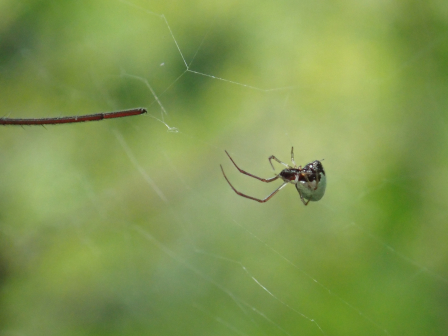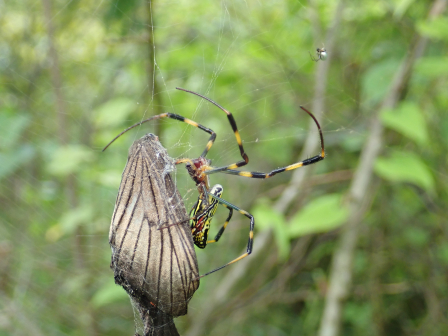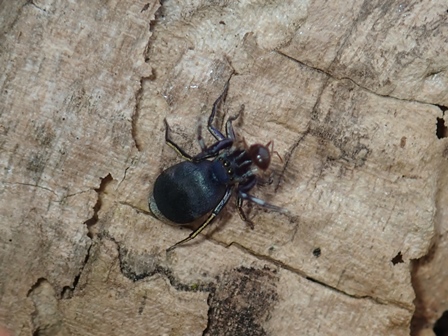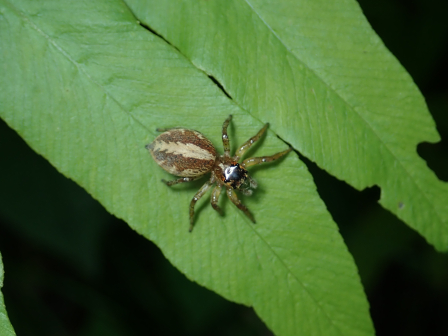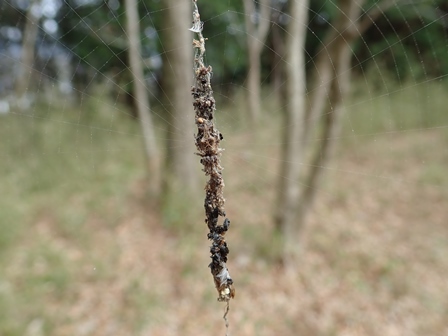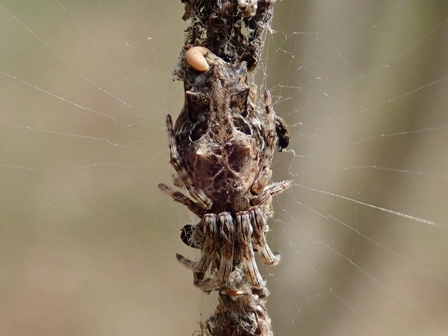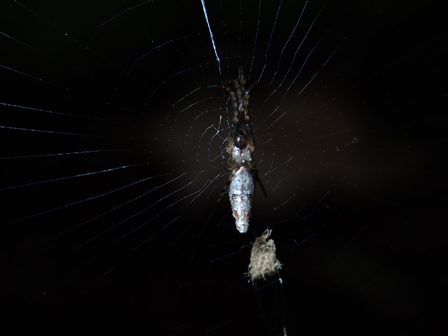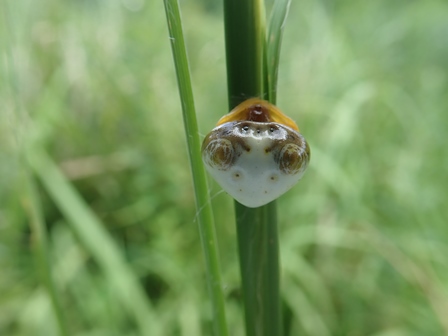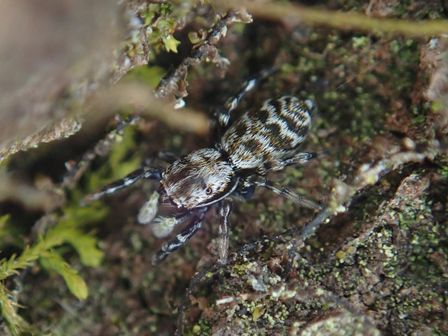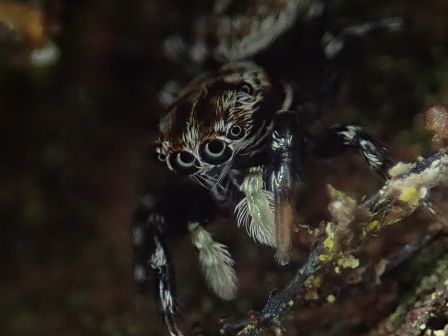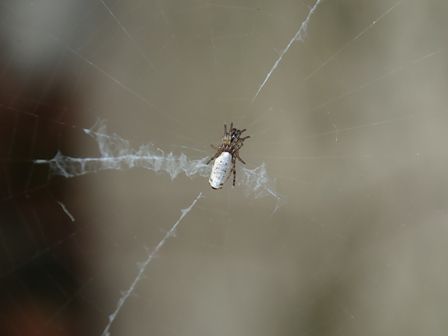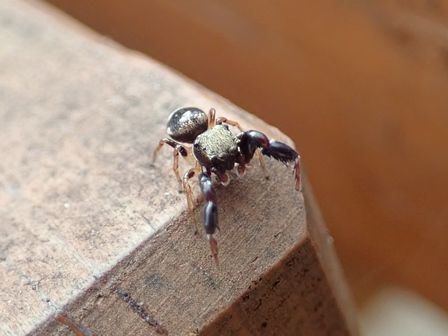フィールド日記
クモ
2022.09.13
スズミグモ
渡り廊下にスズミグモがいました。和名は巣に住むクモという意味だそうです。もともと温暖な地域に住むクモですが、分布を北に広げています。
I found a spider called "Suzumi-Gumo (スズミグモ)". The name means spiders living in a nest. They originally live in southern area of Japan but now they are spreading toward the north.
2022.09.02
シロカネイソウロウグモ
前回紹介したジョロウグモの写真の右上に、小さいクモが見られます。シロカネイソウロウグモです。名前の通り、他のクモの網に居候して、獲物を盗み食いして生きています。本種は特にジョロウグモの巣を好むようです。
You can see a small spider on the upper right in the photo posted last time. This spider is called "Shirokane-Isourou-Gumo (シロカネイソウロウグモ)". The name suggests that this spider lives on another spider's web and steals prey to eat. This species prefers especially "Jorou-Gumo" spiders' web.
2022.08.30
ジョロウグモ
共生の森でジョロウグモが目立つようになりました。ジョロウグモの成虫は秋から初冬にかけてよく見られるようになります。人家の周りから山地まで様々な環境に生息しています。写真の個体はちょうどアゲハモドキを捕食しているところでした。
"Jorou (ジョロウ)" Spiders are more notable in the Kyoseinomori (共生の森). The adults of the spiders are often seen from fall to early winter. They live in various places not only around houses but also in mountains. The one in the photo was just eating a moth called "Ageha-Modoki (アゲハモドキ)".
2022.06.28
アオオビハエトリ
カエデの木の上に、アリを食べているクモを見つけました。図鑑で調べたところアオオビハエトリのメスのようです。ハエトリグモは巣を作らず、飛びついて獲物を捕らえます。本種は特にアリを好んで食べるようです。
I found a jumping spider eating an ant on a maple tree. According to a reference book, this one is a female and is called "Ao-Obi-Haetori (アオオビハエトリ)". Jumping spiders don't build webs, so they jump to a prey and eat it. This species especially likes to eat ants.
2022.05.13
デーニッツハエトリ
裏道でデーニッツハエトリを見つけました。ハエトリグモのなかまは、とても良い視力をもっており、クモの巣はつくらずに、眼で見て獲物に飛びつきます。本種は、草地や雑木林の草の上でよく見られます。
I found a jumping spider called "Plexippoides doenitzi (デーニッツハエトリ)" on the back road. Jumping spiders have good eyesight, so they don't build webs. They catch their prey with their eyes. This species is often seen in grass fields and on the grass in forests.
2021.12.24
ニシキオニグモ
図書館の渡り廊下で、ニシキオニグモを見つけました。大きさはメスで12~18㎜ほどある大型のクモで、山地の神社や寺院でよく見られます。腹部には複雑な美しい模様があります。静岡県では準絶滅危惧種に指定されています。
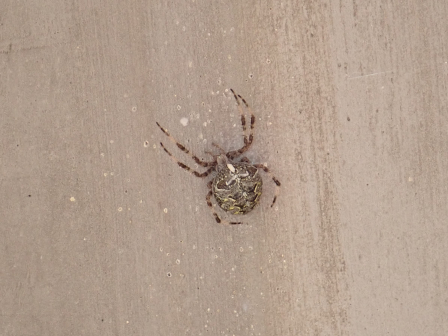
I found a spider called "Nishiki-Onigumo (ニシキオニグモ)" on the corridor to the library. They are a large spider. The female ones are from 12mm to 18mm in length. They are often seen in shrines and temples on mountains. They have beautiful patterns on their abdomen. They are designated as near-threatened species in Shizuoka prefecture.
2021.03.23
ゴミグモ
共生の森でゴミグモを見つけました。ゴミグモは巣の中心に食べかすや脱皮殻などのゴミを帯状に付着させる習性があります。
ゴミの中にはゴミグモが潜んでおり、ゴミに擬態することで捕食者から身を守っていると考えられます。しかし、写真をよく見ると、腹部の先端に幼虫が見られます。これはクモに寄生するクモヒメバチの幼虫です。ゴミグモの擬態もクモヒメバチを欺くことはできないようです。
I found a spider called "Gomi-Gumo (ゴミグモ)". "Gomi (ゴミ)" means "trash". They literally have a custom that they gather trash like leftovers and put them on the center of their webs. They hide in the trash to protect themselves from attacks of their predators. However, taking a closer look, you can find a worm on the tip of the abdomen. It is a larva of a wasp that parasitizes spiders. It seems that the mimicry of the spiders can't trick wasps.
2020.11.10
ギンナガゴミグモ
ヒノキ林でギンナガゴミグモを見つけました。名前の通り、腹部に銀色の光沢があります。また、網を張るクモはふつう下向きに止まることが多いですが、この仲間は上向きに止まるという特徴があります。
I found a "Ginnagagomigumo (ギンナガゴミグモ)" in the Japanese cypress woodland. The word "Gin (ギン)" in its name means "silver" and its body is actually silver. In general, spiders wait for preys on its web facing downward but this species waits facing upward.
2020.09.08
トリノフンダマシ
ススキ野原でトリノフンダマシを見つけました。名前の通り、昼間は鳥の糞に擬態して、じっとしています。トリノフンダマシは夜行性で、網を張り、ガを専門に捕らえて食べていると言われています。
I found this spider called "Torinofundamashi(トリノフンダマシ)" in the Japanese pampas grass field. The name means "mimicking birds' droppings". This spider literally mimics a bird's dropping and stays on a leaf to hide from predators in the day time. In the night, this spider makes a web and catches mainly moths.
2020.08.25
アズチグモ
ナンバンギセルの花の中にアズチグモがいました。アズチグモは木や草の花の上に潜んで、花を訪れたハエやチョウなどの昆虫を捕らえます。体色は白や黄色など変異があります。目の部分が逆三角形の形をしているのが特徴です。
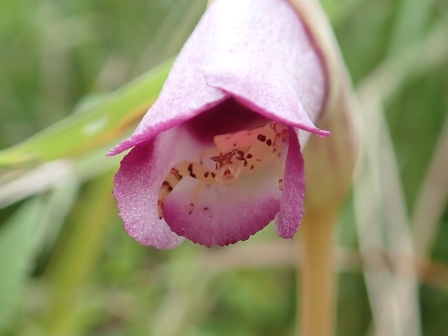
I found "Azuchigumo(アズチグモ)" spider in "Nanbangiseru(ナンバンギセル)" flower. "Azuchigumo" spiders hide in flowers and they wait for their prey like butterflies and flies. We sometimes find different colors of spiders such as white and yellow. One of the characteristics is the triangle shape of their eyes.
2019.03.05
イナズマハエトリ
共生の森近くのクリの木の樹上にイナズマハエトリがいました。腹部背面にある稲妻のような模様が名前の由来のようです。ハエトリグモの仲間はいわゆるクモの巣をつくらず、歩き回って小さな虫などを捕らえています。
そのため、ハエトリグモは大きな眼をもつことが特徴です。この大きな眼でしっかり獲物を見て捕らえます。
2019.02.05
ギンメッキゴミグモ
共生の森でギンメッキゴミグモを見つけました。名前の通り、腹部が銀色に輝いています。網をはるクモは一般的に頭を下に向けて止まりますが、本種は頭を上に向けて止まる特徴があります。ゴミグモという名前ですが、網にゴミをつけることはなく、幼体期に隠れ帯をつくるそうです。隠れ帯とは写真に見られる白い帯状の糸の装飾のことです。
2018.10.09
ウデブトハエトリ
高校3年生の生徒に、昼礼広場のベンチに見慣れない虫がいますと呼ばれて行ってみると、4mmほどの小さなハエトリグモがいました。ハエトリグモはいわゆるクモの巣を作らずに、歩き回って獲物を探し、捕らえます。そのため、眼が大きく、良い視力をもっているといわれています。


